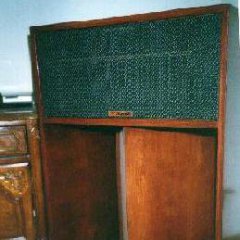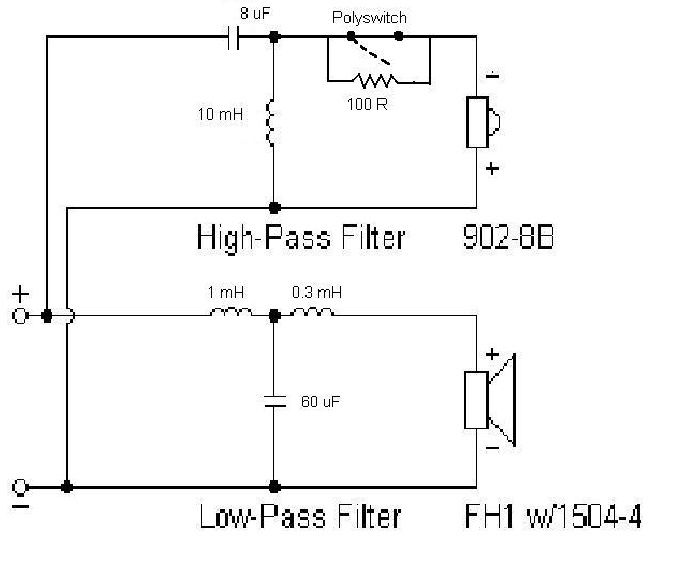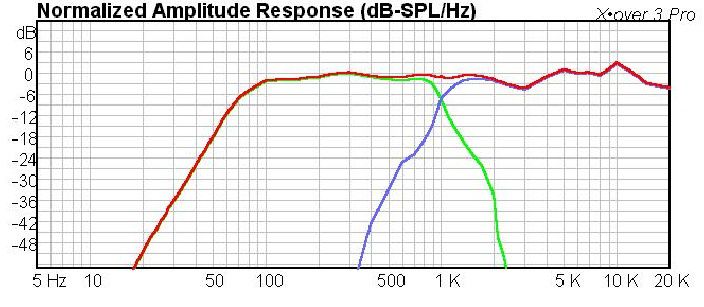-
Posts
5893 -
Joined
-
Last visited
-
Days Won
1
Content Type
Forums
Events
Gallery
Everything posted by JohnA
-
What is your new amplifier?
-
The change is easy. Just add water and stir! This is the crossover design I listen to all day. I used a spare screw for the .35 inductor because I wanted to see if I liked it. As happens, temporary becomes long lasting. Modify your tweeter circuit to match this, and a Type A becomes a Type AA (without zener diodes, the KLiP tweeter protection). I recommend adding the inductor shown to knock the K-55-Vs 9k response "bounce" down a little and maybe balance the squawker's phase shift from the high-pass cap. If your tweeter circuit connects downstream of the 13 uF cap, no worries, that is the original Klipsch design. When I had to replace my caps 18 years ago, I changed it, not understanding how it worked and thinking it was weird. The Type AA also EQs a 105 dB hump in the K-77/T-35's response down to 103-104. I think you'll like that, unless your room is dead.
-
Yes, or anything else/nothing at all. Not knowing the impedance of the speaker, the designer could do no more than a hatchet job on a filter. Wired across the amp terminals, I'll bet on an RC low-pass with an attempted -3 dB point in the 15kHz range since the web page mentioned not taking out too much sparkle, or some-such.
-
Sett the crossover point 10 to 20 Hz above the rated low frequency limit of the speaker. Set the sun's level with a sound meter or by ear so that you can't tell there is a sub in the system.
-
The cabinet walls are short and there are "braces" (screw blocks) at the edges to hold the back and motorboard in the front. Your best upgrade is to make new, thicker (3/4") backs, or stiffen the back with a diagonal bar, and seal the corners of the screw blocks with a good wood glue that doesn't shrink. I screwed pieces of the riser base, at an angle, to the inside back of my factory backs to stiffen them. I can't use the riser bases anymore. Consider a thin rubber gasket for the back, also.
-
Might that be because sales are down? Might that be a regular tool in their business?
-
W code will have Type AA networks. AL started with X. I have one of each. 28W077 was the 27,077th La Scala made.
-
It depends on the horn. A short, thick horn may not benefit. Rope caulk will be the easiest on a plastic horn. Ignore the nay-sayers. It won't hurt, even if it doesn't help. And since it's out .........
-
Where do these rumors come from? And why spread them?
-
Sorry, OHP, I just found your question. Yes, I made them, I did not want to modify those particular Heresies. I put terminal cups into the back of my Center and rear channel Heresies.
-
Hi Mike! I use twisted and braided CAT5E speaker cable, about 11 ga equivalent. So, Klipsch set up a double blind test of speaker wire at one of the early Pilgrimages in Indy, comparing braided CAT5 to some nasty little test lead wire. The CAT5 was flat, -3 dB at something like 300 kHz and 2 Hz (?). I chose CAT5 about 40% of the time. Guessing should have scored 50%. I have wire that tests Uber perfect (low resistance, capacitance and inductance from the braiding and insulation), but I can't hear the difference on my La Scalas. I did hear an improvement in the KLF-C7 I used back then. Buy fairly thick wire, a little oversized because it's cheap to do, with excellent connectors (gold plated if you can) and call it good. For 25' I wouldn't use less than 12 ga. That is what I use in my DJ/Band rig. As to the receiver, buy a name you know, but insist on one with manual calibration. A buddy cheaped out on a Sony. There is only one way to set levels; plug in the mic it has and push a button. If you don't like it, or want more subwoofer, tough. If it has Audessey, fine, as long as you can set the speaker levels and adjust tone manually with a sound meter. Then, go to Parts Express and buy one. A rating of 100 watts/channel should be your minimum, because a receiver will no longer send rated power to all channels at once. (Bad.) TV and Blu-ray are good units, you need a good receiver to match.
-

Continually tripping protection circuit(s) at volume
JohnA replied to Emjay's topic in Technical/Restorations
Besides being an ancient thread, did the OP find a problem, or was the friend just severely abusing his gear? -
No. Resistance doesn't "slow" anything. It just robs some voltage and current from the output of the capacitor (converting it to heat). But the ESR might not be the same at all frequencies adding flaws to the passing signal.
-
Years ago I made a similar comment, loudly, about golfers during the Hotter'N'Hell 100 as I rode by on my bike. The Temp was 111F. They didn't react that I could tell.
-
Actually, I was trying not to denigrate a particular brand as cheap and poor performing. Some of Cheng Shen's motorcycle tires are satisfactory to riders I know, that consider price important. Maybe I should have used "Hop Sing" or "Kwan Do".
-
Speakerlab. Not saying they wouldn't sound nice and be enjoyable. Should be cheeep.
-
Richard, Edgar has nailed it perfectly in his 2 posts. Capacitors don't block anything but DC. They do, in a simple high pass filter, make lower frequiencies quieter. And tires are a wonderful analogy. A Chung King Sport+ is round and black just like a Michelin Sport Cup 2, but you'd rather have the Michelin on the Dragon (and they might cost $700 each). Some cheap caps might have holes in their metalized film and arc at higher voltage, adding a tick sound or maybe a V-shape at the peak of a waveform. Perhaps the material separating the conductors has a different dielectric coefficient at different frequencies yielding an uneven response curve. Or, maybe the dielectric is weird in some other way that delays the transition of the waveform from positive to negative. You might view that like "crossover distortion" in a Class B tube amp. There are many other ways for one cap to damage the sound vs another, and even your wallet. But since there is no perfect device, you want one with hinges that won't tarnish, at least.
-

HERESY: Center Channel in a 1957 MONO System???
JohnA replied to Cathedral Guitar's topic in Ask the Historian
And You Suck! 😁 -

Can La Scala II AL5's be Modified/Upgraded?, etc.
JohnA replied to Wolfbane's topic in General Klipsch Info
Having never heard them, why would you ask? (No, it is not required.) Modding for modding's sake is really a fool's errand. -
Hmmm. Not an easy choice, really. I have H IVs and La Scala Is. The LS IIs have a very similar driver compliment, but a much more sophisticated crossover network and stiffer bass horn. The H IVs have a tight sound, well integrated so that I cannot locate any of the drivers. They go deep enough you don't need a subwoofer if well placed. They seem a little dark or heavy with mid-bass at first (esp. when compared with the Heresy Is they replaced), but later I realized they reproduce vocals of all types extremely well. I no longer use my subwoofer with them. My La Scalas have a light, effortless sound. Detailed and clear with little hint there is a speaker over there. Expect to begin identifying different drum head materials. LS IIs will sound a little more like the H IVs in that overall presentation. Call them cousins and the new La Scala AL5 a sister. If you just cannot get subwoofers in the room with La Scalas, get H IVs. You'll miss the resonance of the notes from low E through A.
-
Well, since the Forte III crosses at 650 Hz, mumps may well be pointless without a crossover network redesign. I can't imagine they'd hurt anything, other than your wallet.
-
What is the crossover point from woofer to squawker in a KLF-30? Mumphs are intended to maintain dispersion at the lower end of the horn's frequency range. If the KLF crosses too high, there won't be any difference.
-
Thanks!! Canada!? I am not surprised at the PX connection. Nashville/Madison is 40 miles from Ft. Campbell. Wonder what happened to their mates?
-
No, you turn the volume control Down at the first hint of distress, brittle sound or distortion regardless of the receiver's power output. This applies to ALL speakers, not just Klipsch. Buy all the quality you can stand. A home theater receiver worth having is not cheap. Look at Sony ES, Marantz, better Yamahas, Integra and good Denons. Accessories4less often has good prices on B-stock and refurbs. The power you need depends on your room size. But, because of the inability of home theater receivers to deliver rated power to all channels at once, start you search at 100 watts and higher.
-

KPT Crossover Assistance Needed for Experiment
JohnA replied to Tony T's topic in Technical/Restorations
You're at the most difficult and detailed portion of a speaker's design. It takes testing, knowledge and trial and error. Were I you, I'd replace the K-55 with an Altec/Great Plains Audio 902-8*, damp the 511B and lose the tweeter. I'll give you a design I did for the 902/511B that was pretty flat and pulls it down to 104 dB/w/M and crosses at 1 kHz. The low pass is for an FH-1 and won't work with your 904-LF.







